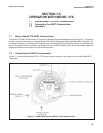
26
MODEL 6081-P pH/ORP SECTION 8.0
PROGRAMMING THE TRANSMITTER
8.3 CHOOSING AND CONFIGURING THE ANALYTICAL MEASUREMENT
8.3.1 Purpose
This section describes how to do the following:
1. Configure the transmitter to measure pH, ORP, or Redox.
2. Determine the location of the preamp.
3. If pH was selected, there are additional selections and settings to make:
a. choose a solution temperature correction curve or set a temperature coefficient constant
b. choose sensor isopotential
c. set reference impedance low or high
8.3.2 Definitions
1. MEASUREMENT. The transmitter can be configured to measure pH, ORP or Redox (opposite sign of ORP).
2. pH SETTINGS. If pH is selected, there are additional settings to make.
a. PREAMPLIFIER. The raw pH signal is a high impedance voltage. A voltage follower or preamplifier, locat-
ed either in the sensor or transmitter, converts the high impedance signal into a low impedance one.
Normally, high impedance signals should be sent no further than about 15 feet.
b. REFERENCE OFFSET. Ideally, a pH sensor in pH 7 buffer should have a voltage of 0 mV. The difference
between the measured voltage in pH 7 buffer and the ideal value is the reference offset. Typically, the ref-
erence offset is less than 60 mV.
c. DIAGNOSTICS. The 6081 continuously monitors the pH sensor for faults. If it detects a fault, the trans-
mitter displays a fault message.
d. GLASS IMPEDANCE. The transmitter monitors the condition of the pH-sensitive glass membrane in the
sensor by continuously measuring the impedance across the membrane. Typical impedance is between
100 and 500 MΩ. Low impedance (<10 MΩ) implies the glass bulb has cracked and the sensor must be
replaced. An extremely high impedance (>1000 MΩ) implirs the sensor is aging and may soon need
replacement. High impedance might also mean that the glass membrane is no longer immersed in the
process liquid.
3. INPUT FILTER. The raw sensor current can be filtered to reduce noise. Filtering also increases the response
time. The filter is the time required for the input to reach 63% of its final reading following a step change.


















